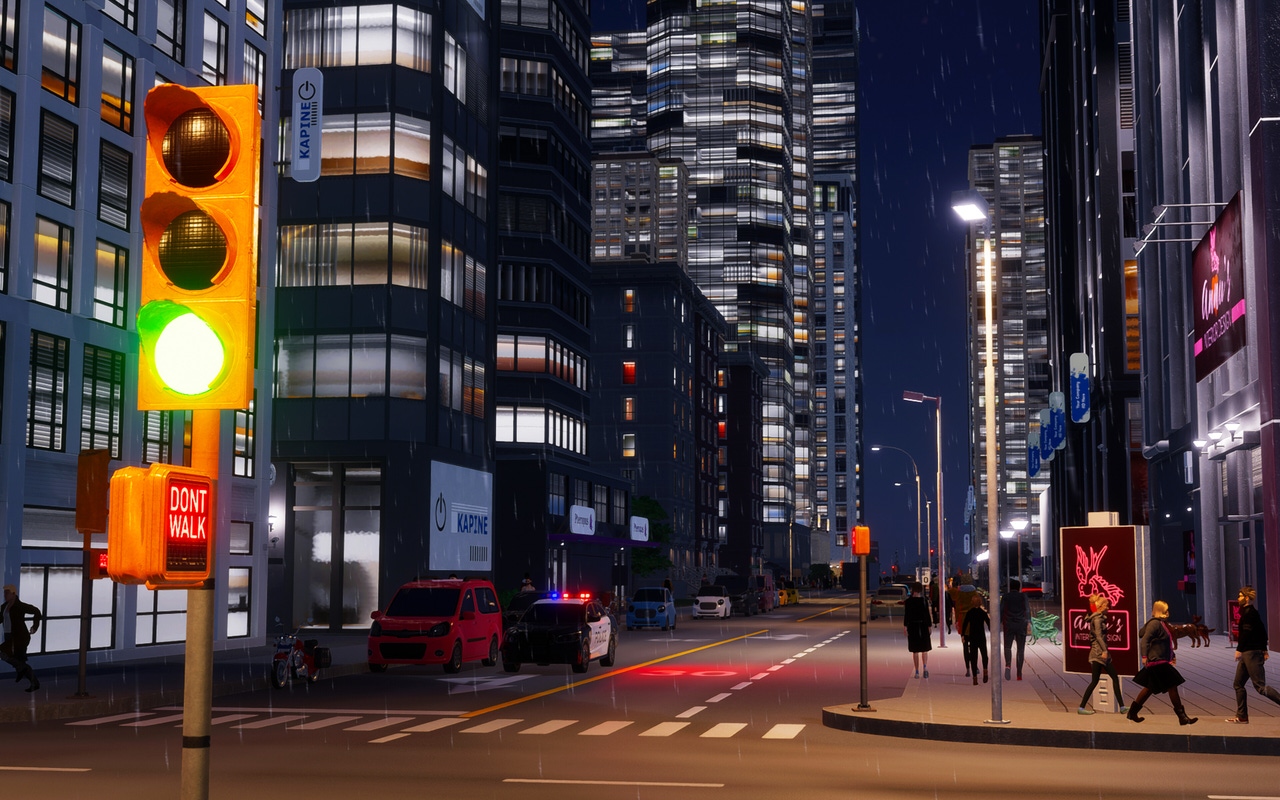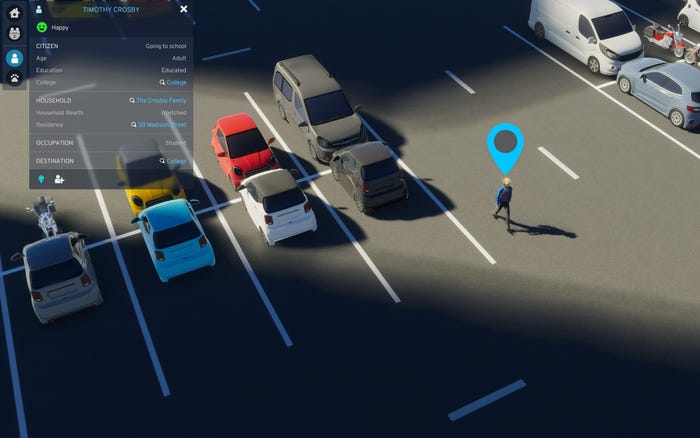Trending
Opinion: How will Project 2025 impact game developers?
The Heritage Foundation's manifesto for the possible next administration could do great harm to many, including large portions of the game development community.

Featured Blog | This community-written post highlights the best of what the game industry has to offer. Read more like it on the Game Developer Blogs or learn how to Submit Your Own Blog Post
Here's how we partnered with Colossal Order to accelerate the production pipeline for creating scores of unique citizens within the world of Cities: Skylines II using our AI-powered, 3D character creation technology.
May 29, 2024

Hello, I’m Raphael Benros, a product marketer at Didimo, working alongside our engineering team to share with you how we partnered with Colossal Order to automate and accelerate the production pipeline for creating the scores of unique citizens featured within the world of Cities: Skylines II using our AI-powered, 3D character creation technology.
The original Cities: Skylines was released by Colossal Order in 2015. For the city-builder genre, the game introduced a comprehensive framework for urban planning, allowing players to tackle complex issues like zoning, road placement, taxation, public services, and overall city management, including budget, health, employment, traffic, and pollution. These elements were combined with a sandbox mode to provide complete creative freedom for players.
Built on the experience gained from their earlier Cities in Motion series, which focused on transportation systems, Colossal Order developed a game engine that could simulate the daily routines of nearly a million unique citizens. This capacity not only deepened the gameplay experience but also helped players intuitively address urban challenges such as traffic congestion. Cities: Skylines stood out for its depth and open-ended gameplay, sharply contrasting with the 2013 SimCity's restrictive elements like always-online gameplay and limited city sizes. The ability to modify the game via the Steam Workshop extended its longevity and fostered a dedicated player community.
Cities: Skylines, while a commercial triumph, initially faced opportunities for enhancement. Early iterations of the game drew feedback for their absence of dynamic elements like natural disasters and random events. Colossal Order positively responded to this input, enriching the game with expansions that incorporated these vibrant features. Furthermore, the game's intricate mechanics, initially challenging for new players, were progressively refined through updates designed to boost accessibility and enrich the user experience, demonstrating the developer's commitment to continual improvement and player satisfaction.
One element Colossal Order sought to improve was the repetitive nature of the non-player characters (NPCs); the original game featured only about 50 different NPC models.
With the sequel, Cities: Skylines II, Colossal Order aimed to surpass their previous. The development team was set on creating a city teeming with unique individuals, reflecting the dynamic variety of real urban populations. This ambition was rooted in the game's new capabilities and enhancements, particularly in character modeling and animation, which were facilitated by advanced technologies like Popul8 from Didimo.
The goal for Cities: Skylines II was clear: enhance every aspect of the game. With improvements like the new Photo Mode, which allows players to zoom in closely on urban scenes, NPCs needed to withstand scrutiny up close—demanding a higher level of detail and realism. This led to a push for significantly more variation among the characters to foster a more inclusive and realistic gaming world.
To enhance the realism and diversity of Cities: Skylines II, Colossal Order meticulously crafted an extensive wardrobe to dress the game's myriad characters, ensuring that each NPC could represent a wide range of professions and lifestyles—from firefighters and police officers to office workers and motorcyclists. This attention to detail extended to seasonal clothing variations, providing warmth in winter and comfort during summer months. However, the true value of these garments would only be realized through the diverse characters designed to wear them. It was imperative that these clothes not only varied aesthetically but also functioned on characters of all shapes, sizes, and backgrounds, making the city's population as vibrant and diverse as its urban landscape.
Popul8 played a pivotal role in achieving the desired diversity in NPCs. The tool enabled Colossal Order’s developers to quickly generate a wide array of character models that could seamlessly integrate into the game’s environment. With Popul8, Colossal Order could easily create varied groups of citizens—each tailored for different seasons, age brackets, and occupations, reflecting a broad spectrum of humanity.
Furthermore, Popul8's asset-fitting capabilities played a crucial role in Colossal Order's ability to rapidly produce a diverse cast of characters. The tool's mathematical approach allowed for precise garment fitting to new body shapes with about 95% accuracy, greatly accelerating the character creation process. This efficiency enabled the developers to focus more on the creative aspects of character grouping, significantly enhancing productivity and diversity in character design. With the bulk of the manual labor taken care of, the Colossal Order team were free to create more variety in characters, check and test important details or continue working on optimizing gameplay ahead of the highly anticipated release.
The creation of NPCs was both a technical and artistic endeavor. Colossal Order was able to use a detailed base mesh that represented their unique art style straight from Popul8. This was then used to generate diverse characters. The tool provided sliders for different physical characteristics and ethnicities, ensuring a wide representation of people. The process also included designing seasonal clothing options in Popul8, allowing characters to change outfits according to the weather, adding another layer of realism.

Image via Paradox Interactive.
The integration of these characters into Cities: Skylines II brought the virtual city to life. Early placeholder characters were replaced with detailed models that interacted with the environment—jogging in parks, taking selfies, and attending street events. This transformation was crucial in making the city feel alive and diverse.
The technical integration also involved ensuring that animations were adaptable to various character forms without glitches. This was particularly challenging for models that deviated significantly from the average build or height, such as children or characters with more unique body types.
One of the most significant technical challenges faced by Colossal Order was the task of rendering a large number of characters within a single scene without overwhelming the player's GPU. Traditionally, rendering a single character consumes up to 50MB of memory, which quickly becomes impractical when scaling up to thousands of characters. To overcome this, the team implemented a memory-optimized format that drastically reduced the memory footprint of each character. This approach enabled the use of batch rendering techniques, where multiple characters are processed in a single draw call. By adopting this method, the game was able to efficiently render scenes with up to 10,000 characters, creating a bustling, lively urban environment without compromising performance or visual fidelity.
One of the key successes of Cities: Skylines II is its reflection of real-world diversity. Characters in the game exhibit a range of ages, body types, and ethnic backgrounds, contributing to a city that feels vibrant and authentic. Each NPC's clothing and behavior respond dynamically to the game’s environmental conditions, further enhancing the realism.
Moving forward, Colossal Order plans to continue expanding the diversity and realism of the character models. This includes introducing more varied animations, accessories, and options for characters with disabilities to broaden the game’s inclusivity.
The development team is also working with the Cities: Skylines II player community, inviting feedback and suggestions on what types of characters they want to see in the game. This collaborative approach’s purpose is to both help enhance the game's development while also ensuring that it remains a living project, continually evolving to meet the desires and expectations of players.
The journey from Cities: Skylines to Cities: Skylines II showcases a significant evolution in how NPCs are created and integrated into a massive, dynamic world. By leveraging advanced tools like Popul8 and embracing a philosophy of diversity and realism, Colossal Order has created a model for how city-building games can be a world that more realistically mirrors the complexity and diversity of our own.
You May Also Like